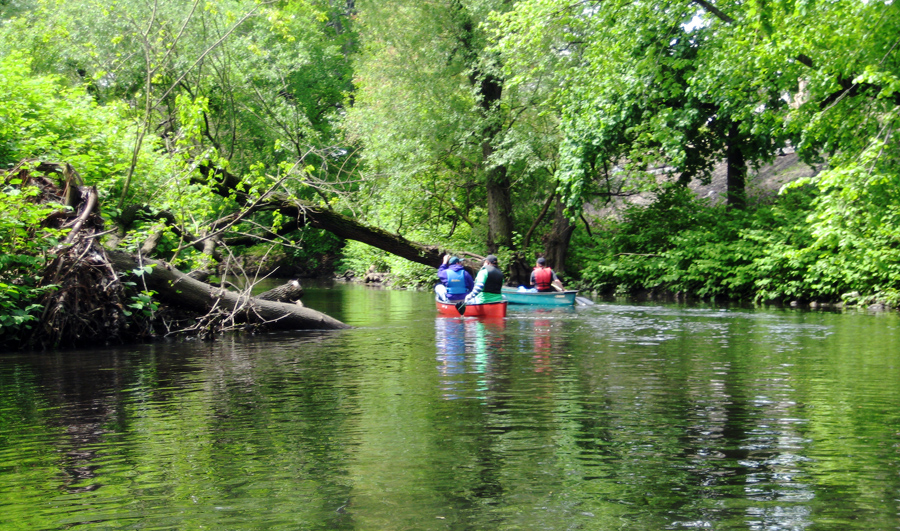
Eric Sanderson wants you to take over your own area of Manhattan, return some of the blocks to forest (if you like), put solar panels on the rest (or, maybe green rooftops) — and by doing so, plunge the entire neighborhood into the future. And then, go ahead and measure the results (with metrics like water management, CO2, natural habitat) and see how your new development compares with the present, or even with the arboreal past.
Sanderson’s new interactive urban design website, Mannahatta2409.org, challenges users to see the natural landscape that is still possible within the city. The ambitious idea is to have visitors use the site’s design tools to try out visions for the future, and to discover for themselves the benefit of urban design that includes nature.

Mannahatta 2409 extends the scope of Sanderson’s celebrated interactive project Welikia, which maps New York City circa 1609—year one, so to speak, of European influence. “Mannahatta” is the name given to the island by the native Lenape people, who inhabited a Manhattan graced by trees and streams rather than skyscrapers and subways. Both projects are part of Sanderson’s work at the Wildlife Conservation Society; by background, Sanderson is an ecologist, now with new roles as natural historian of the city and visionary interactive developer.
With the new site, beginning from the pre-development Manhattan of 1609, users can re-envision and build the city from the ground up, or start with the present-era Manhattan of 2009 to grapple with contemporary issues. Choosing from a variety of options, including 65 different ecosystem types, building and street types, and transportation and water source options, users can tailor every aspect their city to their preferences. But in the virtual world of Mannahatta, building is accompanied by close attention to environmental factors and repercussions. With each step of development the program reports ecological impact: how does your city perform in terms of water management, carbon emissions, biodiversity, and population? Can you make a city that performs better than a forest?
The site’s design tools are very deep. A brief walk-through of ‘how to choose model scenarios’ on one of the project’s tutorial videos gives a glimpse of the how thoroughly described the new world you design will be:
You don’t have to work alone. In addition to your own vision, users can view and build upon the designs of others to figure out the best policies in maximizing ecological performance while maintaining economic and population standards. The scale of the project can be as ambitious or as narrowly focused as you choose: redesign the entire island, or pick a few blocks to make over.
The designs of individuals can afterwards be combined to create an entirely new map of New York built by a network of users, harnessing collective problem solving as a way to move towards a portrait of a virtual, sustainable NYC.

In trying out the program, I used Mannahatta 2409 to re-imagine the neighborhood surrounding my college campus, Morningside Heights. Starting with the current infrastructure of the neighborhood, I used tools on the website to include green roofs, photovoltaic panels, vegetable gardens, and bike lanes. I also added features around my college campus to help mitigate climate change, like a greenhouse and a vertical farm to supplement the diets of people living in the area.
As I added these elements one by one to my dream neighborhood, I could compare the environmental performance of my vision to that of Morningside Heights circa 1609 and the Morningside Heights of 2009, directly measuring the impact of every development along the way.
Perhaps one of the most thoughtful features of Mannahatta 2409 is its consideration of the role of lifestyle in shaping ecological impact. Users can choose to populate their Manhattan with a set of inhabitants ranging from the average American to native Lenape to eco-hipster. As Mannahatta suggests, the future of our city isn’t only about the kind of buildings we erect; it’s about the way we live and interact with our environment on a daily basis.
Using Mannahatta 2409 has changed the way I interact with my everyday surroundings. I see the reality of my neighborhood through the potential of my Mannahatta modifications and imagine ways the campus can be improved. I can see my reality against the possibilities that could be.
Combining environmental awareness with human creativity, Mannahatta2409 invites us into a new kind of conversation about the future of our city – and it allows you, figuratively, to get your hands dirty with the work of planning ahead.